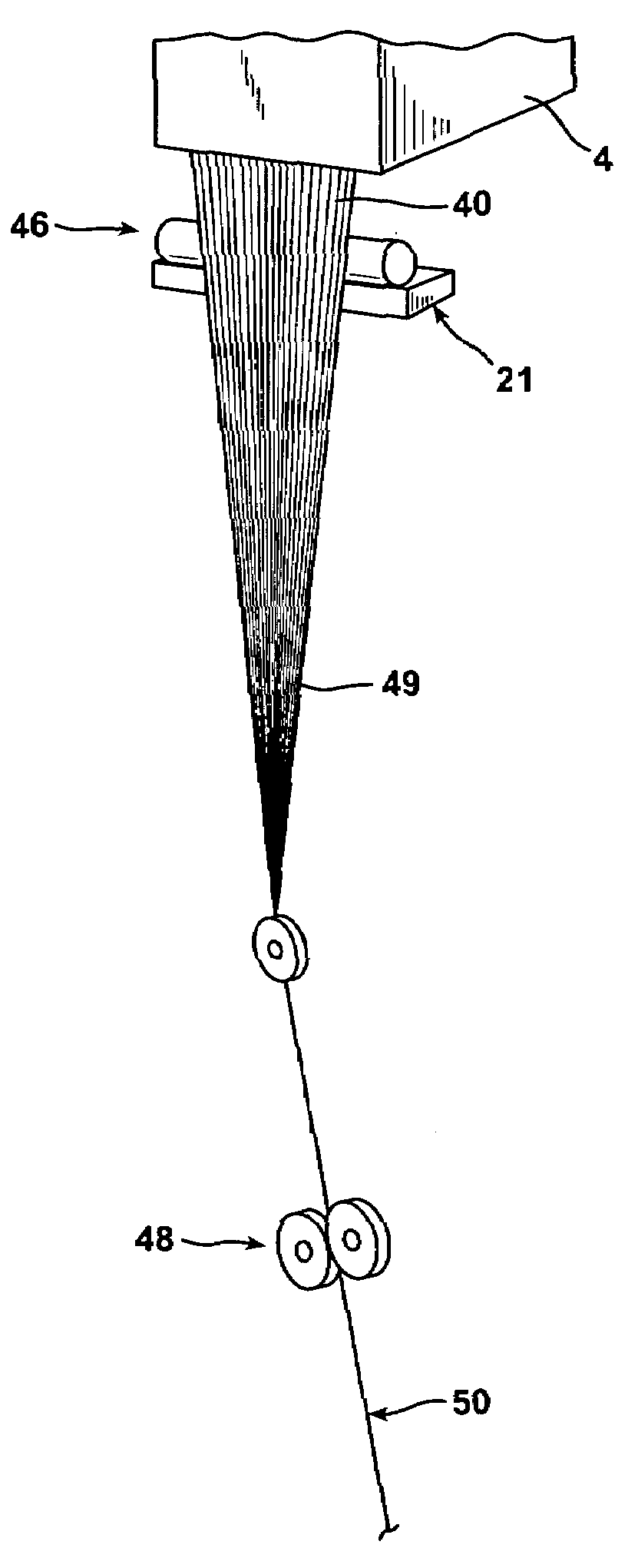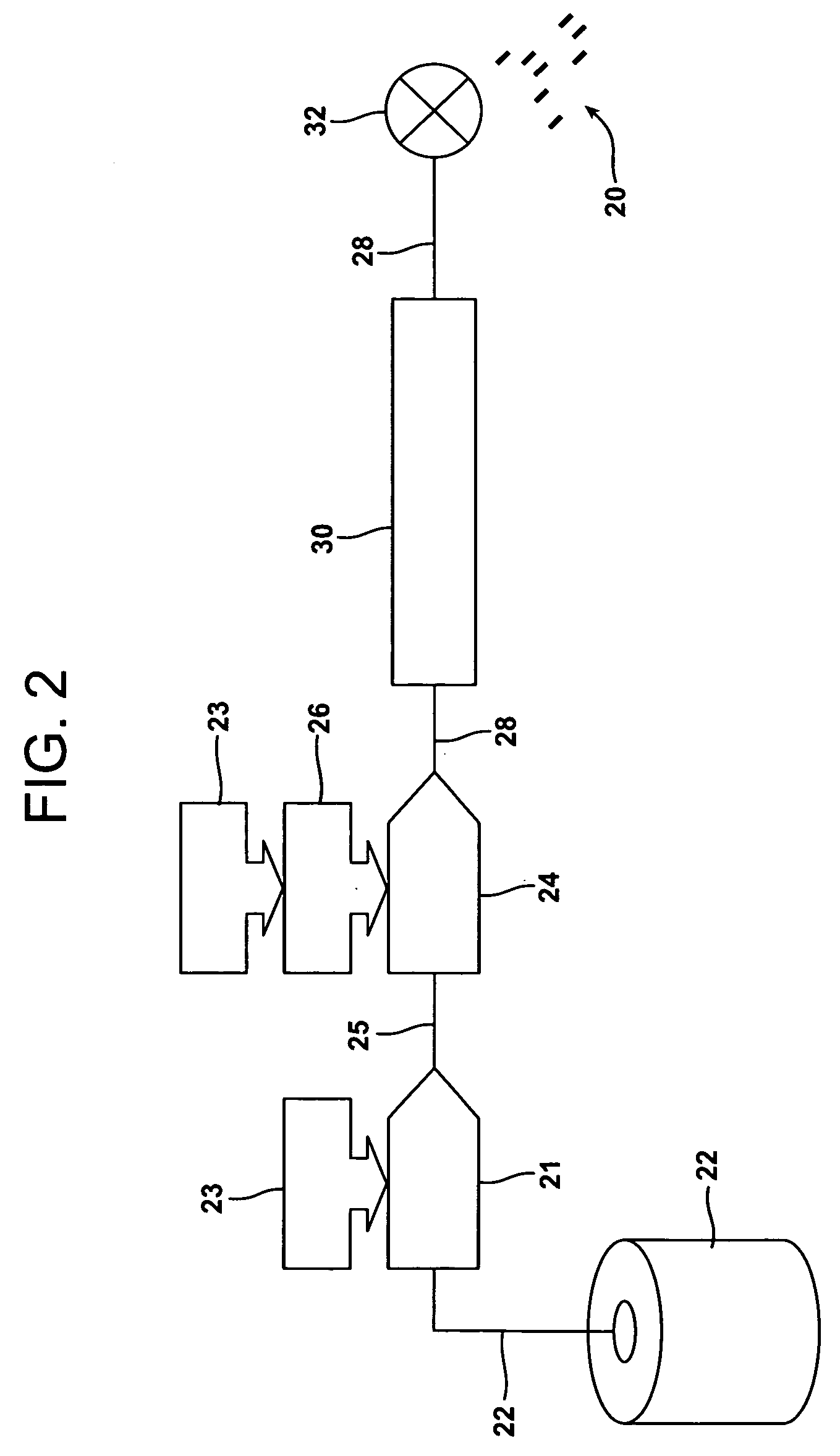Chemical coating composition for glass fibers for improved fiber dispersion
a technology of chemical coating and glass fiber, which is applied in the direction of cellulosic plastic layered products, natural mineral layered products, other domestic articles, etc., can solve the problems of inconsistent part quality, undesirable visual defects in the final composite product, and glass fibers that do not always disperse well, etc., to achieve excellent fiber dispersion, improve mechanical properties, and reduce visual defects
- Summary
- Abstract
- Description
- Claims
- Application Information
AI Technical Summary
Benefits of technology
Problems solved by technology
Method used
Image
Examples
example 1
[0082]A continuous glass fiber that had been pre-applied with an aqueous, conventional sizing composition (i.e., including a film forming agent, a coupling agent, and a lubricant) and dried in a conventional oven was utilized as the input fiber material in a wire coating process. The input fiber material was wire coated using the wire coating process depicted in FIG. 1. The wire-coated strand was then passed through a cooling bath and chopped into pellets having length of approximately 12 mm and a glass content of 30% by weight. The pellets were then molded into a molded plate using a molding machine used for producing long fiber thermoplastic (LFT) molded plates. As shown in FIG. 4, the molded plate contained numerous undispersed fiber bundles over the entire surface of the plate (shown as white spots on the plate). An X-ray of the molded plate was produced (FIG. 5). The X-ray clearly shows undispersed fiber bundles throughout the plate as white spots. It is to be appreciated that ...
example 2
[0083]A continuous glass fiber pre-applied with an aqueous, conventional sizing composition (i.e., including a film forming agent, a coupling agent, and a lubricant) and dried in a radio frequency drying apparatus was utilized as the input fiber material in a wire coating process. A coating composition formed of an ethoxylated fatty alcohol (ethoxylation with n=20 ethylene oxide monomers and a C18 fatty alcohol) was applied in-line as shown in FIG. 2 at a level of 10% by weight prior to running the coated glass fiber strand through the wire coating device. The wire-coated strand was then passed through a cooling bath and chopped into pellets having length of approximately 12 mm. The pellets were then molded into a molded plate using a molding machine used for producing long fiber thermoplastic (LFT) molded plates. A photograph of the molded plate is shown in FIG. 6. It can be seen in FIG. 6 that the molded plated formed by utilizing fiber strands coated with the inventive coating co...
example 3
[0085]A continuous glass fiber pre-applied with an aqueous, conventional sizing composition (i.e., including a film forming agent, a coupling agent, and a lubricant) and dried in a radio frequency drying apparatus was utilized as the input fiber material in a wire coating process. A coating composition formed of an ethoxylated fatty alcohol (ethoxylation with n=20 ethylene oxide monomers and a C18 fatty alcohol) was applied in-line as shown in FIG. 2 at a level of 8.0% by weight prior to running the coated glass fiber strand through the wire coating device. The wire-coated strand was then passed through a cooling bath and chopped into pellets having length of approximately 12 mm. The pellets were then molded into a molded plate using a molding machine used for producing long fiber thermoplastic (LFT) molded plates. A photograph of the molded plate is set forth in FIG. 8. It can be seen in FIG. 8 that the molded plated formed by utilizing fiber strands coated with the inventive coati...
PUM
| Property | Measurement | Unit |
|---|---|---|
| Melt viscosity | aaaaa | aaaaa |
| Mechanical properties | aaaaa | aaaaa |
| Thermoplasticity | aaaaa | aaaaa |
Abstract
Description
Claims
Application Information
 Login to View More
Login to View More - R&D
- Intellectual Property
- Life Sciences
- Materials
- Tech Scout
- Unparalleled Data Quality
- Higher Quality Content
- 60% Fewer Hallucinations
Browse by: Latest US Patents, China's latest patents, Technical Efficacy Thesaurus, Application Domain, Technology Topic, Popular Technical Reports.
© 2025 PatSnap. All rights reserved.Legal|Privacy policy|Modern Slavery Act Transparency Statement|Sitemap|About US| Contact US: help@patsnap.com



